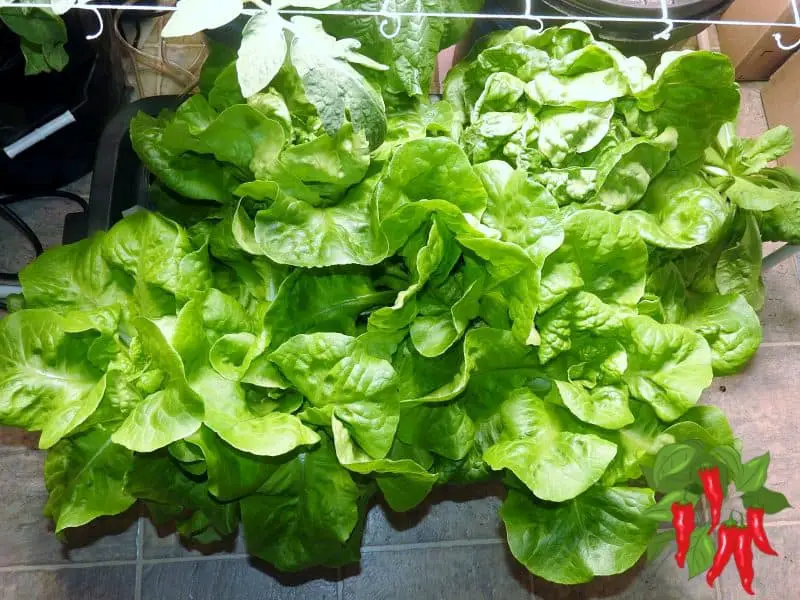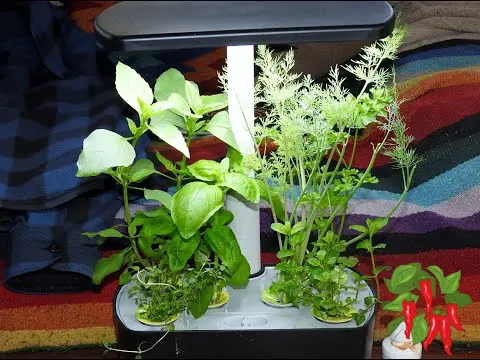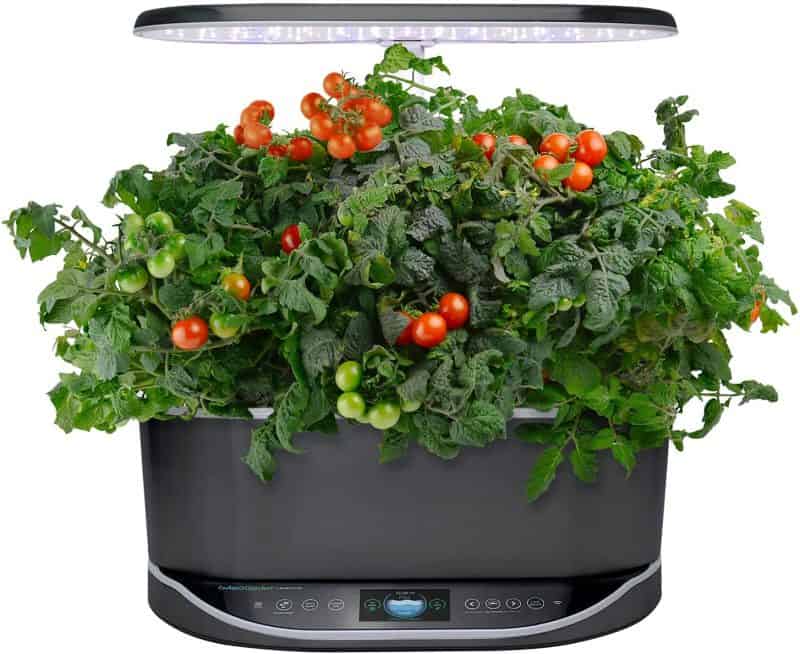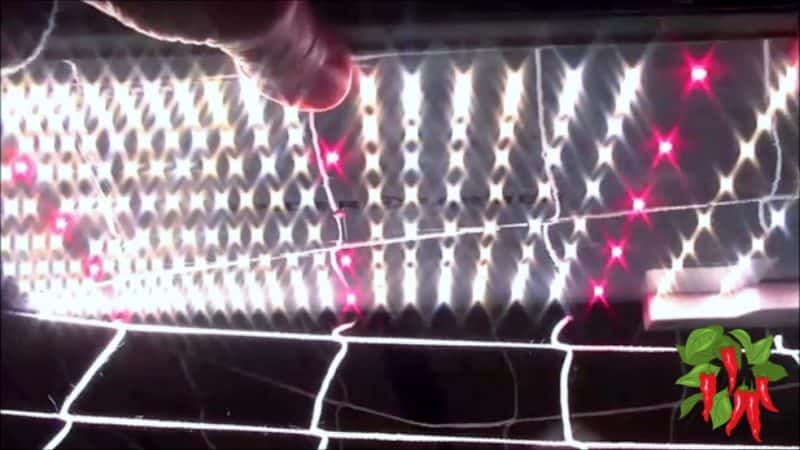This post contains affiliate links. If you buy something from one of our links we may earn a commission. Thanks
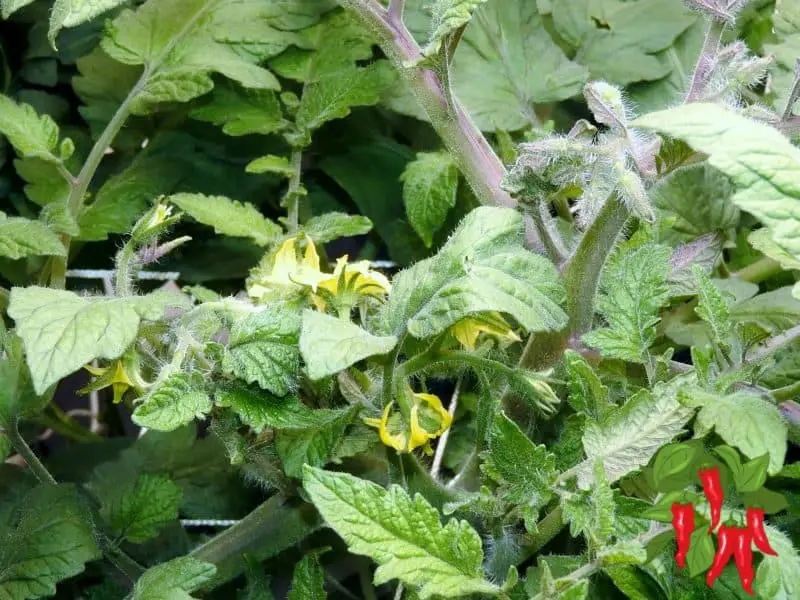
Discover the joys of a hydroponic apartment garden. Learn to grow fresh veggies in small spaces with our easy tips and tricks. Perfect for urban green thumbs!
Hydroponic Home Garden Key Takeaways:
- A hydroponic home garden is an innovative way to grow plants without soil, using nutrient-rich water.
- It’s ideal for small spaces and enables faster plant growth and higher yields.
- This method is perfect for apartments due to its compact, soil-less setup.
Let’s embark on a journey of hydroponic apartment gardening!
Whether you’re a seasoned gardener or a beginner, this guide will show you how to transform your apartment into a lush, productive garden.
From compact systems to easy-to-grow veggies, we’ve got you covered.
Starting a Hydroponic Indoor Garden
Are you thinking about starting a hydroponic apartment garden? Not sure where to start?
I will show you two of the best hydroponic systems for apartments in my video, and also a few veggies you might want to grow.
To set up a hydroponic apartment garden, you want a system that is compact. Hydroponic systems allow you to grow without messy soil. Plants grow faster in hydroponics and yield more.
Hydroponic Apartment Garden – DWC Veggies
DWC or deep water culture is a fantastic way to grow vegetables. For my apartment hydroponics DIY project, I used 5-gallon buckets and 10 gallon totes to make my hydroponic system.
It’s not complicated to build, and you may already have containers you can repurpose.
But you will need at least one air stone for each container you use.
DWC is the best hydroponic system for tomatoes. So if you want to grow larger plants like tomatoes or peppers, this is really the best way to go.
Here is how to set up your bubble buckets for tomatoes or other large plants.
DWC Tomatoes Easy Deep Water Culture Setup (indoorvegetablegrower.com)
Bush Early Girl Hybrid Tomato
My tomato is starting to flower and I spread it out over my trellis netting. I wanted to make sure I could support the fruit
This is a Bush Early Girl Hybrid Tomato from Burpee Seeds. It is very healthy, but actually, this tomato is a bit disappointing to me.
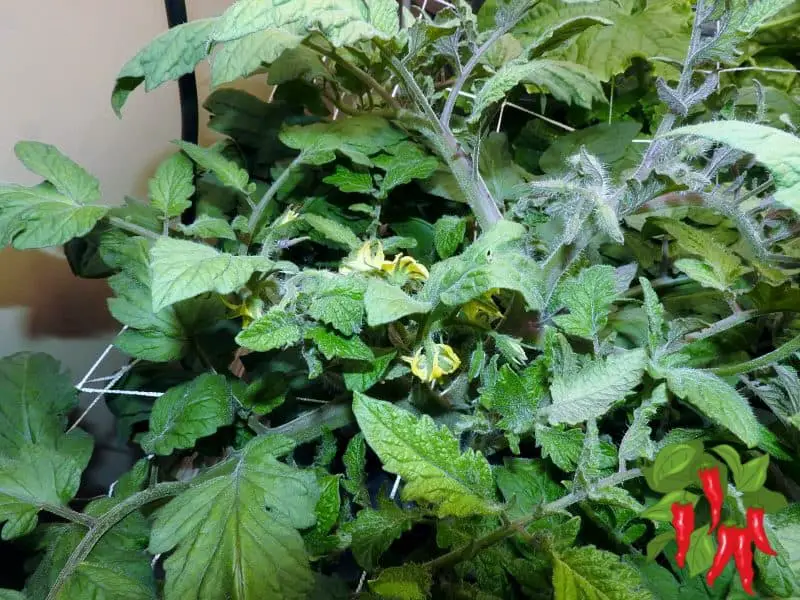
It flowered on top, but I don’t see any flowers lower down, so yield will probably not be that great.
It’s a bush variety, so it is a determinate tomato variety. I think next time I’m going to grow an indeterminate variety.
If you don’t know the difference, a determinate variety grows like a bush like this and it bears most of its fruit at the same time.
Whereas an indeterminate tomato grows tall and it’s more like a vine, it fruits over a much longer period of time so you can constantly be harvesting fruit.
Determinate tomatoes are good for outdoor gardens especially if you live in a fairly cool climate.
They’ll mature faster and also if you’re into canning or something like that, most of the crop will be ready at the same time.
So that’s the advantage of a determinant tomato, but for indoors I think an indeterminate variety is a better choice.
It will yield more over a longer period of time, but it requires more training than a bush tomato.
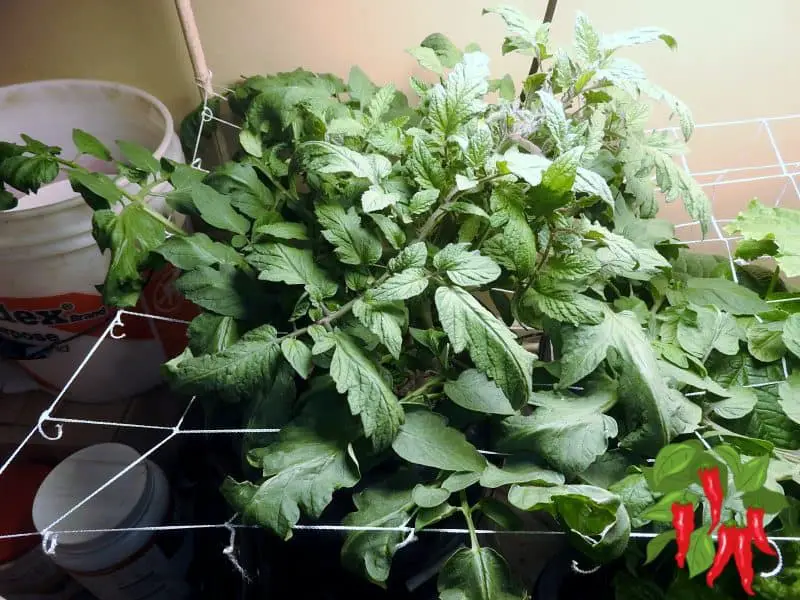
Bush Champion Cucumber
This is a cucumber, and it’s supposed to be a bush variety and have short vines. I sure hope so anyway.
You can see it just sent out its first runner. I’m going to train that along the outside edge of the trellis.
So I’m kind of excited to see what that cucumber does in a small space.
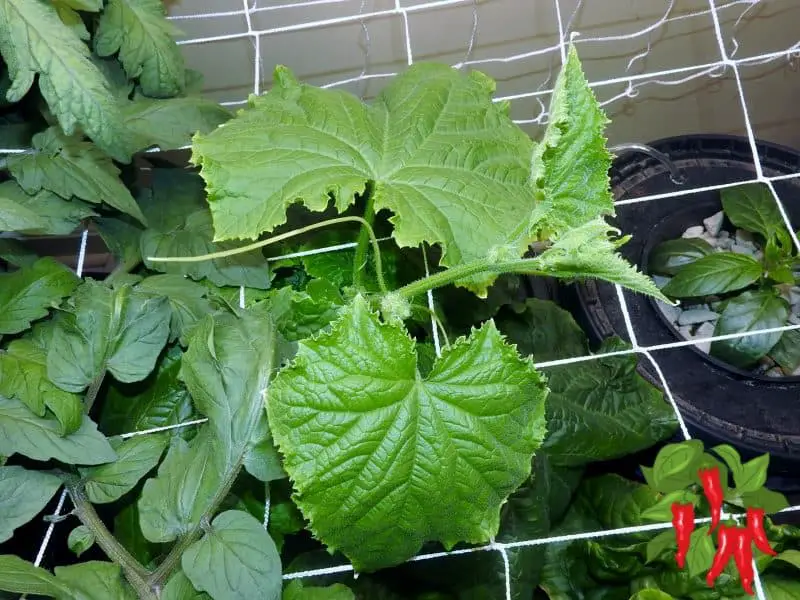
I have never grown a bush cucumber before, either indoors or out. They claim it only has a 2-foot spread and makes a lot of large cukes.
It is really healthy and vigorous, and the bucket has a lot of roots in it. Much more than the other plants have.
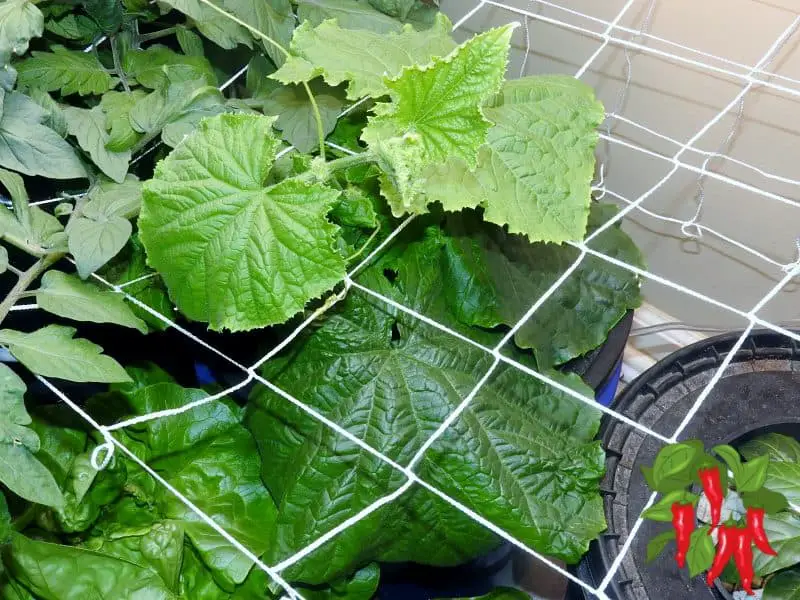
Bush Belle Hybrid Pepper
This is a Bush Belle Hybrid pepper plant. Again, a bush type. Because I am indoors, I looked for plants with a more compact growth habit.
If you look closely, you can see that it has flowers on it. I’m probably going to pick those first flowers off.
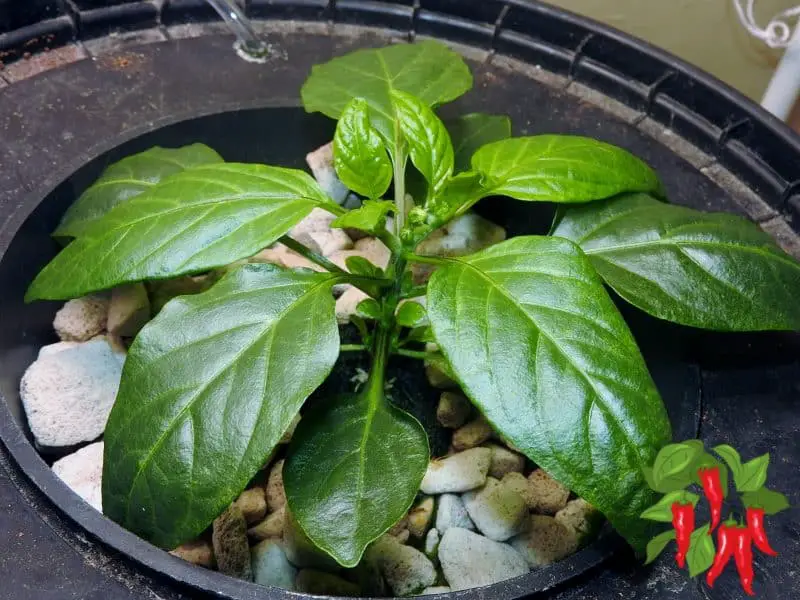
I want to give the plant a chance to grow and get a little bigger before it flowers.
It would probably grow just fine like that, but I think trying to ripen those peppers at this point might stunt the plant.
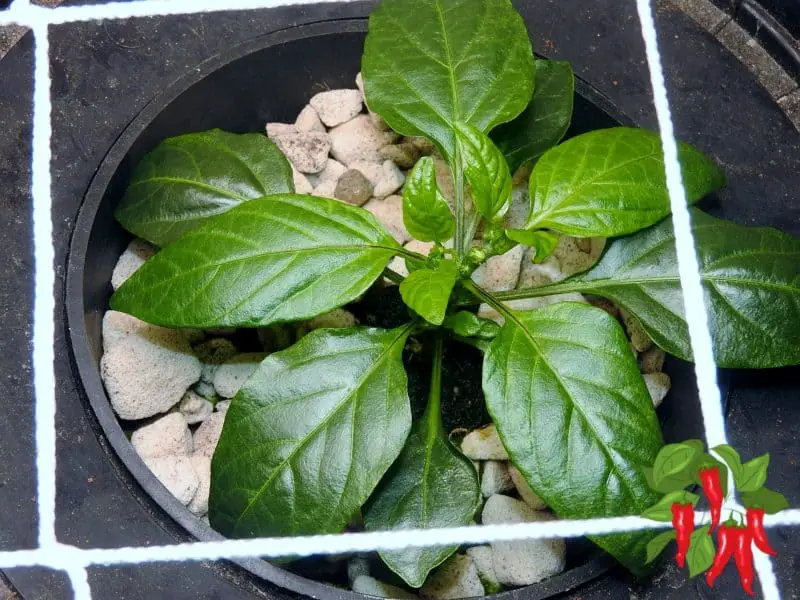
Buttercrunch Lettuce
Here we have a bunch of Buttercrunch lettuce and one here on the end is just about ready to harvest.
The other plants are a bit smaller. There were actually 12 plants in this tote. Six were leaf lettuce and 6 were Buttercrunch lettuce.
Leaf lettuce matures much faster than heading lettuce. So they were harvested and made more room for my Buttercrunch lettuce.
These are in a 10-gallon tote and I have holes cut in the lid made to hold three-inch net pots.
You can add lettuce transplants or seeds in a jiffy pellet to the pot and fill around them with hydroton.
Then you fill the tote up with water up to the bottom of the pots, and you put an airstone in it, and you are good to grow.
It’s a great setup for lettuce, but you can grow other greens or even herbs in it too.
Growing Vegetables Indoors Functionality Vs Appearance
A tote doesn’t take up too much space, and it’s not too god-awful ugly, either. Mostly what you’re going to see are the large green tops.
Growing vegetables indoors in your apartment means you have to make a choice between functionality or appearance.
Personally, I don’t think that the buckets look that bad, and I don’t mind them at all because they are functional and grow my food.
But if you’re more into your indoor decor, it’s probably not the most attractive thing that you can have in your living room.
It really just depends on what you want to do.
My DWC Kitchen Garden
For me, this two-by-four-foot space inside my kitchen works and I don’t think it looks bad when it is full of plants.
I use a frame from an old grow tent I had to hang my light and support a trellis net.
I have a Spider Farmer SF2000 hanging over my veggies. It is a good-sized light for a two-foot by four-foot area.
Again, it’s not super attractive hanging here like that. But if you’re going to grow indoors, you’re going to need a light.
If you have a balcony that gets six hours of sunlight a day, you can grow with no supplemental light out there.
But inside your apartment, the light levels are just not going to be bright enough to really get the kind of production that you want.
Vegetables grow outdoors and usually in full sun. So when you bring them into your apartment the light levels are a lot lower.
You can’t really get a good crop indoors without lighting. You can try it, but I think you’ll be disappointed with the results.
I’d rather see you spend some money and buy an LED grow light and have a really successful grow.
I also have an AeroGarden Harvest that I keep out in my living room, and that’s a great one if you only have a small area to grow food.
Best Hydroponic Systems For Apartments
If you have a small apartment and don’t have enough room for a larger system like DWC buckets, the AeroGarden is the obvious answer.
Deep water culture systems are highly effective for growing vegetables, but let’s face it, they are not pretty. Highly functional yes, but attractive looking no.
So even if space is not limiting you, something more attractive might be a better match for your decor.
AeroGarden Harvest Best Hydroponic Apartment Garden
The AeroGarden makes a great little hydroponic apartment garden. It has a built-in light and because it has a small footprint you can even fit it on a shelf.
I have used mine to grow my own herbs, and now I am going for chili peppers. It is very easy to use. No green thumb is needed.
I really do think it is the best hydroponic system for small spaces.
So I have an Aerogarden Harvest that has 6 pods or growing sites. They make other sizes too like the Bounty with 9 sites and the Farm is bigger still.
So this is six-pod unit had herbs in it originally. But I decided to grow chili peppers instead.
So I have six chili peppers in there. And you can’t keep six in there permanently because when they start growing they’ll get too big.
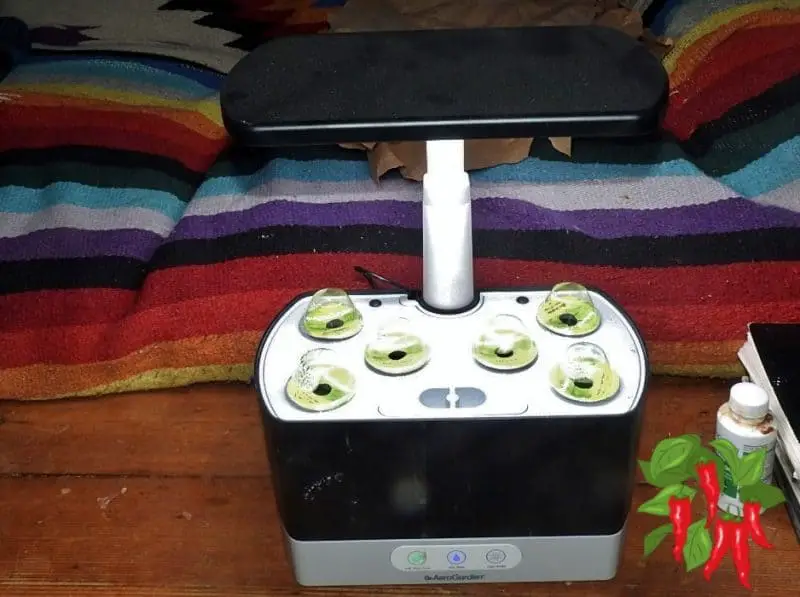
Probably two or three is the maximum you would want in there. So my plan is to start 6 of them in there.
And I will remove half of them to repot and go outdoors once it warms up.
But I really wanted to show you this unit because it’s sitting here on a coffee table, and it’s maybe 10 inches long and six inches wide, and the light is built into it.
The light telescopes up or down. So I think on this one it goes up to about 16 inches and if you’re willing to prune them you can grow peppers or even small patio tomatoes in one of these.
Spider Farmer SF2000 LED Grow Light
To get the most from your veggies, you are going to provide light to them. Most apartments will not have enough light for them.
The Spider Farmer SF2000 is a full spectrum LED grow light made for growing vegetables and other plants.
It is reasonably priced for its quality and uses 200 watts at the wall. It does not put out a lot of heat, either.
You don’t really need to run it for more than 12 hours at a time, although you can run it longer.
Plants do also need a dark cycle to grow, so I would not run it any longer than 18 hours.
It also has a dimmer and I would suggest you run it on a timer, so it goes on and off at the same time every day.
Hydroponic Apartment Garden Final Thoughts
I think my AeroGarden really doesn’t look all that bad. It’s way more attractive than a bucket or a tote. I think it can fit in just about anywhere.
And if you’re short on space this is a great option for growing your own vegetables.
The best thing about the AeroGarden is that it really works. You know it’s silent, fits anywhere, doesn’t use a lot of electricity and it is virtually bulletproof.
When you start growing for the first time I think it is important to be successful.
So everything is on a timer. Your light goes on with a built-in timer. When you need to add plant food or water a warning light flashes.
There’s a little pump inside that keeps everything flowing and it’s on an automatic timer too.
Actually, I think it looks pretty good and if you’re really short on space think about the AeroGarden.
Otherwise, I really like my DWC buckets and it’s the best for big plants.
If you want to grow smaller plants, lettuce is going to be the easiest thing to grow and it also needs less light.
Tomatoes are a high light crop they probably need more light than anything else you’ll grow indoors.
So if you’re not going to have a lot of light I’d say try lettuce. You can definitely do that on a balcony.
You might even get away with it near a sunny window but I wouldn’t expect the same harvest you would get if you had a good full-spectrum LED over it.
The one I am using is a Spider Farmer SF2000 and it cost about 300 bucks. So it’s not cheap but it’ll light a 2 foot by 4-foot area.
It uses 200 watts at the wall and it will last you for years. So if you think about it you probably spend more than $300 a year buying vegetables.
So I think it’s worth the investment and you’ll have it for a long time.
If you get tired of growing vegetables you can grow house plants under it or flowers.
Hydroponic Home Garden FAQs
The journey of hydroponic apartment gardening often brings up a host of questions, especially for those new to this innovative method of cultivation.
In this FAQ section, we address some of the most common inquiries about hydroponic gardening in apartment settings.
From understanding the feasibility of hydroponics in limited spaces to exploring the simplest DIY systems, and discussing the challenges and limitations of this soil-less gardening method, we’ll provide you with the insights you need to start your hydroponic garden confidently.
Let’s dive into these frequently asked questions to help demystify the world of hydroponic apartment gardening.
Q: Can you do hydroponics in an apartment?
A: Yes, you can certainly practice hydroponics in an apartment. Compact systems like the AeroGarden or homemade deep water culture setups are ideal for small indoor spaces, making it possible to grow a variety of plants efficiently.
Q: What is the easiest DIY hydroponics system?
A: The easiest DIY hydroponics system for beginners is the deep water culture (DWC) system. It requires basic components like 5-gallon buckets or 10-gallon totes, air stones, and net pots, making it accessible and simple to set up.
Q: What are 3 disadvantages of hydroponics?
A: The three main disadvantages of hydroponics include the initial cost of setting up the system, the continuous need for electricity to power water pumps and lights, and the learning curve involved in managing nutrient solutions and pH levels accurately.
Q: What cannot be grown hydroponically?
A: It’s challenging to grow large, root-heavy crops like potatoes and carrots hydroponically. Perennial plants that require a dormant period also do not fare well in hydroponic systems, as these setups are designed for consistent, year-round growth.
Conclusion
In conclusion, hydroponic apartment gardening is a highly rewarding endeavor that blends functionality with the joy of growing your own food.
Whether you’re constrained by space or just looking to add a green touch to your urban living area, hydroponic systems offer a practical and efficient solution.
From the simplicity of DWC setups to the sleekness of AeroGarden units, these systems cater to varying aesthetic preferences while ensuring abundant yields.
As we delve into the key takeaways from this exploration of apartment-friendly hydroponics, remember that each system holds the promise of a lush, productive indoor garden that thrives year-round.
Hydroponic Home Gardening: A Blend of Functionality and Aesthetics
- Space Efficiency: Hydroponic systems like DWC and AeroGarden are perfect for apartments, offering high yields in limited spaces.
- Versatility: These systems can grow a variety of plants, from tomatoes and peppers to lettuce and herbs, catering to different culinary preferences.
- Aesthetic and Practical Considerations: While DWC buckets are highly functional, systems like AeroGarden offer a more attractive option for those concerned about home decor.
- Investment in Growth: Although there’s an initial investment in lights and equipment, the long-term benefits of fresh, home-grown produce make it worthwhile.
- Ease of Use: With features like built-in timers and automatic nutrient dosing, these systems are user-friendly, ensuring a successful gardening experience even for beginners.

